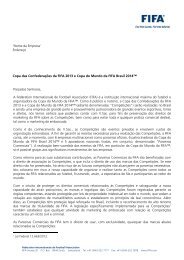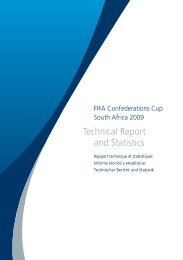You also want an ePaper? Increase the reach of your titles
YUMPU automatically turns print PDFs into web optimized ePapers that Google loves.
48 Technical and tactical analysis<br />
Technical and<br />
tactical analysis<br />
The <strong>2010</strong> <strong>FIFA</strong> World Cup South Africa showed that nearly<br />
all teams now play with a <strong>com</strong>pact defence and are able to<br />
put even the strongest opponents under pressure. The most<br />
successful teams were fl exible and able to adapt their style<br />
of play to the match situation. It was this fl exibility, together<br />
with the teams’ healthy aggression and the players’ excellent<br />
technique, that paved the way to success. Spain, the<br />
Netherlands, Germany, Uruguay, Brazil, Ghana, Argentina,<br />
Chile and the USA all provided the best examples of this.<br />
The World Cup also showed that excessive <strong>com</strong>bination play<br />
can lead to a lack of aggression.<br />
The most successful teams also boasted fast, tricky<br />
attackers who were dangerous in front of goal. Uruguay,<br />
for example, were the perfect example of a solid team<br />
that performed well and enjoyed success. In Forlán<br />
(10) and Suárez (9), they had a strikeforce that posed a<br />
threat to every defence. Brazil (Luis Fabiano (9), Robinho<br />
(11)), Argentina (Tévez (11), Higuaín (9)), Spain (Villa (7),<br />
Torres (9)/Pedro (18)) and Germany (Klose (11), Müller (13))<br />
all had attacking players who were capable of winning<br />
matches on their own. Individual pieces of skill could also<br />
turn matches in other ways, however. In modern football,<br />
it is diffi cult to get in behind the opposition defence as<br />
teams are often very <strong>com</strong>pact at the back with eight or<br />
nine players behind the ball. That is why teams now need<br />
outstanding individual players who can make their mark<br />
in one-on-one situations down the centre of the pitch but<br />
particularly down the wings, where they can drive as far<br />
as the opponent’s goal line to create space that often does<br />
not exist down the centre of the pitch. Once they have<br />
reached the goal line, these players do not always look<br />
to cross the ball high into the penalty area, but instead<br />
they often look to cut the ball back along the ground for<br />
on-rushing team-mates.<br />
Formations<br />
As mentioned above, the successful teams were built around<br />
a well-drilled tactical system. In addition, they all had a well-<br />
organised defence that still gave the players the freedom<br />
to express themselves and use their own strengths while<br />
pushing forward.<br />
The teams played with a back four, with the exception<br />
of New Zealand, Algeria and Chile, who had three-man<br />
defences.<br />
Ten teams had a traditional starting formation of 4-4-2 with<br />
two banks of four behind two strikers, with one of these<br />
strikers often playing in a more withdrawn role. England,<br />
the USA and Paraguay were good examples of this. It<br />
should be noted, however, that these teams were also able<br />
to make changes and adjustments depending on the match<br />
situation or to take advantage of their players’ individual<br />
qualities.<br />
Argentina’s 4-4-2 formation had a four-man diamond in<br />
midfi eld, whereas Brazil fi elded two defensive midfi elders<br />
and two wingers who came inside when possible to make<br />
room for their advancing full-backs. Ghana, meanwhile,<br />
played with two men in front of the defence as well as with<br />
three midfi elders to help out in both attack and defence.<br />
Another tactical formation was 4-3-3, which was used<br />
by teams such as Mexico, Japan and Cameroon. In this<br />
formation, a defensive midfi elder played in front of the back<br />
four and was fl anked on either side by another midfi elder,<br />
with three strikers up front. As soon as the team lost<br />
possession, the wide strikers dropped back to form a nineman<br />
defensive block with the midfi eld and defence to try<br />
and prevent the opponents from building attacks. When<br />
their team was attacking, they tried to exploit the space<br />
down the wings as quickly as possible.<br />
Of the four semi-fi nalists, only Uruguay played in a<br />
formation that resembled 4-4-2, although the position<br />
occupied by Forlán (10) merits further examination.<br />
Although he was in principle a striker, he mostly played







